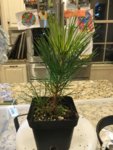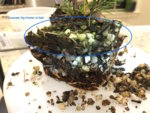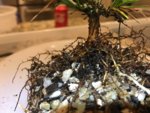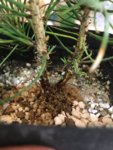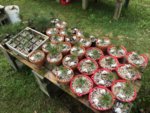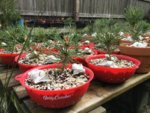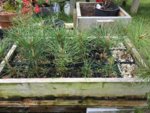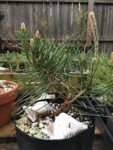So I have been noticing over the past few months that my soil percolation has been pretty awful in my JBP seedling pots. I believe this is mostly due to me dumping piles of organic fertilizer on top of the soil combined with the heavy, torrential rain we receive.
I would say that almost half of the cuttings started out in individual pots have needles starting to yellow and even turn a redish / brownish hue on top. Not sure if some of this could be because of the colder weather we have had lately but it was enough to get my attention.
I took some photos and plan to upload within the next few days.
Upon investigation, the upper portion of the soil, above where the cutting rooted (one thing i will note later is i think i planted the cuttings to deep), had completely clogged from organic fertilizer turning the upper soil into concrete, literally. So I decided to go ahead and repot one of the seedlings showing the color issues and one that was still green, just to do a test (I have a ton of these things). Both were handled very carefully. I didn't bare root, only scraped the soil away about the basil flare, lightly loosened and potted up in a larger pot. I tried to remove as much of the cutting propagation medium as possible without disturbing the roots (i did cut like two small crossing roots on each). I figured hell since i have to bring these in for any freezes anyway i might as well early repot a few. It would almost make since in this situation, if roots still grow at temps over 40F that repotting now could help growth next year. We will see. I only did that on two, one healthy and one not so much.
Well, after that i started dreaming that night about all the upcoming rain. Sometimes here in the winter it rains all the time followed by cold cool whether (not cold for you northern guys). I was dreaming that all my pines would start showing bad color and severely set them back next year unless i did something to them all.
So starting the day before thanksgiving and during thanksgiving and even yesterday, i took each pine and did the following:
- pulled all dead / brown needles off
- scrape / excavate out all "concrete" soil above the basil flare of the cutting
- gentely removed as much of the propagation medium without disturbing the roots much
- replace with a 2 part pearlite, 2 part Optisorb, 1/2 part bark mix on top (this is all i had on hand)
I think this will be ok as i stopped working on each one when i got to the roots. I definitely planted my cuttings pretty deep. In a typical 3-4inch tall container, the roots only had about 1-2in depth to grow in. Most of the seedling cuttings had buds covered in the concrete soil that i left exposed when i replaced with the new soil.
A couple things to consider for lessons learned (I need to gather up all my lessons learned from year one and make a separate post. Hopefully i remember to do so).
- cuttings root super easily if placed in the shade for about 6 weeks before moving to sun (i had cuttings that i through out into the side yard under a tree that didnt even get hormone that rooted on top of the ground, in shade though)
- Use a smaller amount of propagation mix to root cuttings. I was worried that the mix would leach out and mix into the surrounding soil over the coarse of the year so I used about a fairly large slug of rooting medium (sand). If i was to do this again, I would only make a small slug, maybe 1/2 diameter by 1" deep, then place the cutting 1/2" down. When i was working on these, the slug was still in its place and in perfect structure so my theory was wrong.
- do not dump / pile fertilizer on soil surface. Maintain the soil by using tea bags or something to hold the fertilizer in place and prevent from entering into the soil.
- Here is a big one, DO NOT USE an automatic watering system on your pine seedlings (IT KEEPS THEM TO WET).
- watch out for caterpillars, they eat pines, even though some of my victims have recovered and are starting to grow pretty cool naturally.

